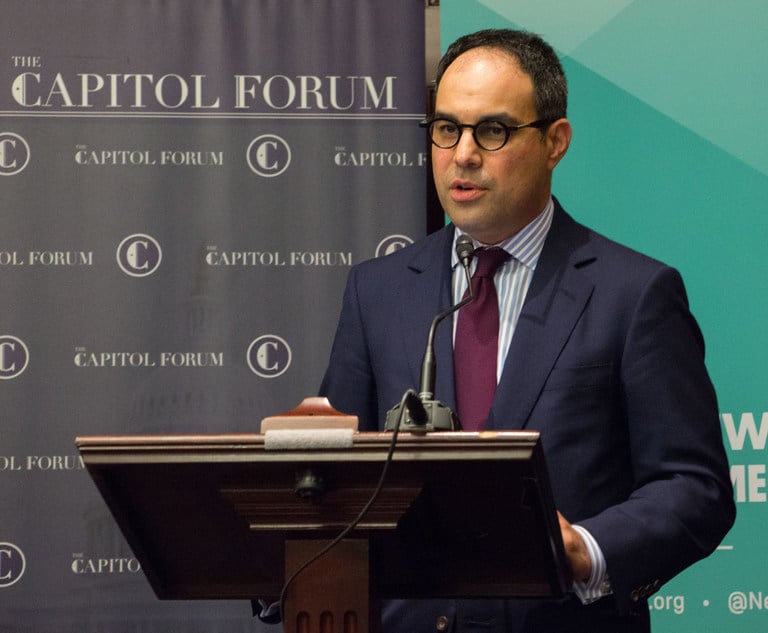Richard Susskind On In-House Lawyers Sharing Risks Through Fee Arrangements
Legal experts weigh in on bold predictions made by scholar Richard Susskind.
October 16, 2017 at 12:28 PM
7 minute read
 Four years ago, Richard Susskind published the first edition of “Tomorrow's Lawyers: An Introduction to Your Future.” With the rapid changes in the legal profession, tomorrow is now today.
Four years ago, Richard Susskind published the first edition of “Tomorrow's Lawyers: An Introduction to Your Future.” With the rapid changes in the legal profession, tomorrow is now today.
The second edition of “Tomorrow's Lawyers” focuses more sharply on how artificial intelligence, alternative business structures, low-cost law firm service centers, legal tech startups and evolving in-house roles are changing the way legal services are delivered and how law schools are educating students to meet those changes.
To that end, ALM during October is publishing excerpts across several of our brands from the second edition to spark thought and conversation about the industry's future among the legal profession's leaders. ALM editors and reporters have solicited reactions—positive and negative—to Susskind's ideas from law firm chairs, top legal educators, general counsel, law students and industry analysts to get their take.
Legal Risk Management
Most general counsel (GCs), the leaders of in-house legal teams, tell me that their principal job should be that of managing risk; that 'legal risk management' should be the core competence and service of in-house lawyers. They often contrast this with what they actually do, which is fight fires—in-house lawyers are faced, on a daily basis, with a barrage of requests, problems, and questions from across their organizations. And they usually feel they have to respond helpfully. In reality, while some of these inquiries merit serious legal attention, others assuredly do not. The hope of most GCs is that they can organize themselves to become more selective; that they can move from being excessively reactive to being proactive. In other words, their job should be to anticipate problems before they arise. The focus should be on avoiding disputes rather than resolving them.
Legal risk can be managed in many ways, but the emphasis is usually on preventing nonlawyers in businesses from inadvertently exposing their organizations to some kind of liability (such as might flow from a breach of some regulation or of an agreement). This control of risk can be achieved, for example, by increasing legal awareness, by introducing protocols or procedures, by using standard documents, or by involving lawyers more directly in the affairs of organizations. Legal risk management can also involve the conduct of audits, risk reviews, and health checks to assess, for instance, an organization's processes for managing regulatory compliance or its preparedness for litigation. There is little question that tomorrow's in-house lawyers will become increasingly systematic and rigorous in their management of risk and will require sophisticated tools and techniques to help them (the most exciting opportunity here is the use of machine learning techniques for risk diagnosis). Strikingly, very few law firms have yet recognized the commercial opportunities here.
Another risk-related trend will be towards the greater sharing of risk between in-house lawyers and law firms. If deals and disputes do not conclude satisfactorily, some GCs believe that the law firms involved should suffer some of the downside, by reducing their fees. With some justification, law firms retort that this should cut both ways, so that the successful conclusion of a legal project should surely then result in an uplift in fees. No doubt, these debates on fees and risk-sharing will intensify in years to come, as economic pressures increase. New ways of allocating risks will evolve, in attempts to incentivize law firms in different ways. One arresting example of this is when in-house lawyers pay law firms bonuses if they help them to avoid litigation.
-Richard Susskind, “Tomorrow's Lawyers, Second Edition”
Analysis
In “Tomorrow's Lawyers, Second Edition,” Richard Susskind points to a trend of a greater risk sharing between law firms and legal departments and predicts that this trend will continue to grow over time.
And while attorneys agree that new fee arrangements have provided for more risk-sharing between legal departments and their law firm partners, they've also pointed to limitations of these set ups.
Stephen Immelt, CEO of Hogan Lovells, said that risk sharing among companies and clients is nothing new, especially in the United States, where he said such arrangements are most common. “Firms and clients have been doing this in various shapes for some time,” he said.
It's been happening in litigation for many years, Immelt said, noting that similar fee arrangements for mergers and acquisitions became more common only in the past decade–largely as a result of the 2008 financial crisis, when collapsed deals became the norm.
Steven Cooperman, partner at Morrison Cohen in New York, has worked both in-house and in private practice and currently focuses his practice largely on M&A and private equity deals.
He said that risk sharing varies from client to client, but companies know law firms are taking a risk by agreeing to “busted deal” discounts, or a reduction in fees if a transaction falls through. “Some clients like the idea of an annual deductible where the firm agrees to eat a certain amount per year across busted deals,” he said.
Risk sharing can also be a two-way street. Susskind writes that outside counsel's “successful conclusion of a legal project should surely then result in an uplift in fees.”
“It depends on the client,” Cooperman said. “Some clients in a particularly successful transaction think it's justified to go above hourly billing. We see that from time to time.”
Although there has definitely been movement away from billable hours in recent years, attorneys noted the well-known structure has far from disappeared.
Immelt said that although the majority of his firm's clients have some type of arrangement where the risks are shared and fees are negotiated, there are a fair number of clients who still prefer to bill the firm on an hourly basis.
William Farrell, general counsel with litigation finance firm Longford Capital Management, said that although some firms rely on contingency fees, most Am Law 100 and 200 firms Longford works with “are pretty wedded to the billable hour model.”
For this reason, it is difficult for law firms to deviate too far from that model. “It's a longstanding billing structure that's been working,” Farrell said.
As for Susskind's “arresting example” of “new ways of allocating risks,” which is “when in-house lawyers pay law firms bonuses if they help them to avoid litigation,” the lawyers said this isn't a typical arrangement.
The biggest reason firms can't be compensated for avoiding litigation is because it's difficult to determine and quantify precisely how big of a role the firm played in keeping the company out of court, the sources said.
Rather than offer a payout for litigation avoidance, Cooperman said, “usually if firms find ways to avoid litigation, it will result in more work for their firm in the future.”

Excerpted with permission from Tomorrow's Lawyers by Richard Susskind. For more information, click here.
This content has been archived. It is available through our partners, LexisNexis® and Bloomberg Law.
To view this content, please continue to their sites.
Not a Lexis Subscriber?
Subscribe Now
Not a Bloomberg Law Subscriber?
Subscribe Now
NOT FOR REPRINT
© 2025 ALM Global, LLC, All Rights Reserved. Request academic re-use from www.copyright.com. All other uses, submit a request to [email protected]. For more information visit Asset & Logo Licensing.
You Might Like
View All
'Giant Killer:' How DOJ's Antitrust Pick Became One of Silicon Valley's Biggest Legal Antagonists
15 minute read
What Millennial Lawyers Want: A Bridge From the Past to the Future of Law Practice
6 minute readTrending Stories
- 1Uber Files RICO Suit Against Plaintiff-Side Firms Alleging Fraudulent Injury Claims
- 2The Law Firm Disrupted: Scrutinizing the Elephant More Than the Mouse
- 3Inherent Diminished Value Damages Unavailable to 3rd-Party Claimants, Court Says
- 4Pa. Defense Firm Sued by Client Over Ex-Eagles Player's $43.5M Med Mal Win
- 5Losses Mount at Morris Manning, but Departing Ex-Chair Stays Bullish About His Old Firm's Future
Who Got The Work
J. Brugh Lower of Gibbons has entered an appearance for industrial equipment supplier Devco Corporation in a pending trademark infringement lawsuit. The suit, accusing the defendant of selling knock-off Graco products, was filed Dec. 18 in New Jersey District Court by Rivkin Radler on behalf of Graco Inc. and Graco Minnesota. The case, assigned to U.S. District Judge Zahid N. Quraishi, is 3:24-cv-11294, Graco Inc. et al v. Devco Corporation.
Who Got The Work
Rebecca Maller-Stein and Kent A. Yalowitz of Arnold & Porter Kaye Scholer have entered their appearances for Hanaco Venture Capital and its executives, Lior Prosor and David Frankel, in a pending securities lawsuit. The action, filed on Dec. 24 in New York Southern District Court by Zell, Aron & Co. on behalf of Goldeneye Advisors, accuses the defendants of negligently and fraudulently managing the plaintiff's $1 million investment. The case, assigned to U.S. District Judge Vernon S. Broderick, is 1:24-cv-09918, Goldeneye Advisors, LLC v. Hanaco Venture Capital, Ltd. et al.
Who Got The Work
Attorneys from A&O Shearman has stepped in as defense counsel for Toronto-Dominion Bank and other defendants in a pending securities class action. The suit, filed Dec. 11 in New York Southern District Court by Bleichmar Fonti & Auld, accuses the defendants of concealing the bank's 'pervasive' deficiencies in regards to its compliance with the Bank Secrecy Act and the quality of its anti-money laundering controls. The case, assigned to U.S. District Judge Arun Subramanian, is 1:24-cv-09445, Gonzalez v. The Toronto-Dominion Bank et al.
Who Got The Work
Crown Castle International, a Pennsylvania company providing shared communications infrastructure, has turned to Luke D. Wolf of Gordon Rees Scully Mansukhani to fend off a pending breach-of-contract lawsuit. The court action, filed Nov. 25 in Michigan Eastern District Court by Hooper Hathaway PC on behalf of The Town Residences LLC, accuses Crown Castle of failing to transfer approximately $30,000 in utility payments from T-Mobile in breach of a roof-top lease and assignment agreement. The case, assigned to U.S. District Judge Susan K. Declercq, is 2:24-cv-13131, The Town Residences LLC v. T-Mobile US, Inc. et al.
Who Got The Work
Wilfred P. Coronato and Daniel M. Schwartz of McCarter & English have stepped in as defense counsel to Electrolux Home Products Inc. in a pending product liability lawsuit. The court action, filed Nov. 26 in New York Eastern District Court by Poulos Lopiccolo PC and Nagel Rice LLP on behalf of David Stern, alleges that the defendant's refrigerators’ drawers and shelving repeatedly break and fall apart within months after purchase. The case, assigned to U.S. District Judge Joan M. Azrack, is 2:24-cv-08204, Stern v. Electrolux Home Products, Inc.
Featured Firms
Law Offices of Gary Martin Hays & Associates, P.C.
(470) 294-1674
Law Offices of Mark E. Salomone
(857) 444-6468
Smith & Hassler
(713) 739-1250






